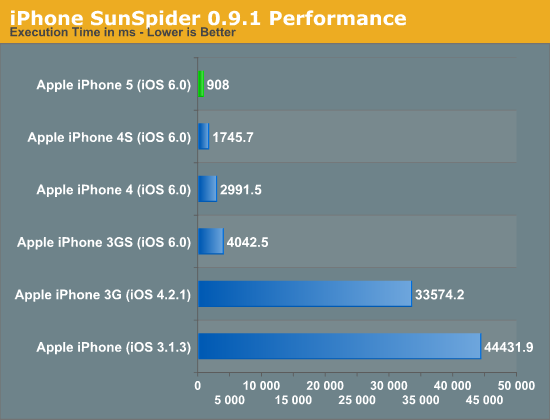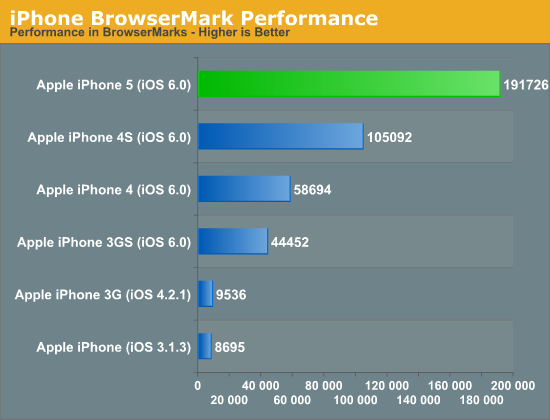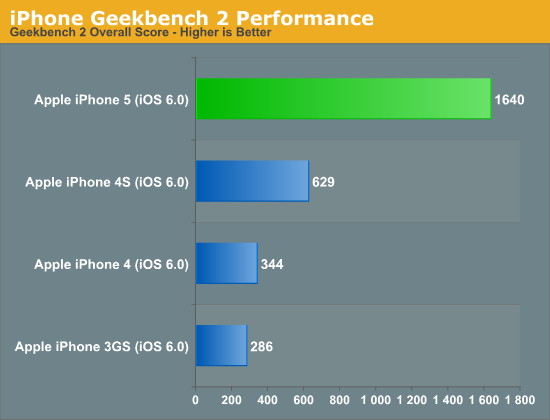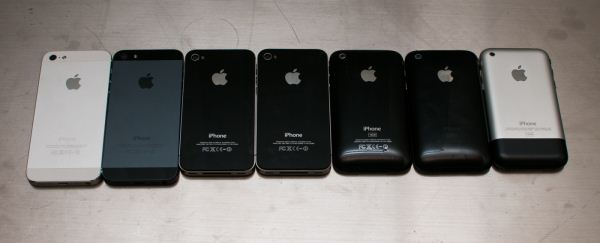The iPhone 5 Review
by Anand Lal Shimpi, Brian Klug & Vivek Gowri on October 16, 2012 11:33 AM EST- Posted in
- Smartphones
- Apple
- Mobile
- iPhone 5
Six Generations of iPhones: Performance Compared
Section by Anand Shimpi
Cross platform smartphone benchmarks are interesting, but they do come with their own sets of issues. Before we get to that analysis however, let's look at how the iPhone's performance has improved over the past six generations. Luckily Brian has a set of all of the iPhones so he was able to run a few tests on all of the devices, each running the latest supported OS.
We'll start with SunSpider 0.9.1, our trusty javascript performance test:

The transition from iPhone to iPhone 3G shows you just how much additional performance you can squeeze out of simply a software change. There's likely even more that could be squeezed out of that ARM11 platform, unfortunately newer versions of Safari/iOS aren't supported on the iPhone 3G so we're left with a runtime that's around 37x the length of a single run on the iPhone 5.
The rest of the devices support and run iOS 6, so we're at least on a level software playing field. The performance boost from one generation to the next is quite significant still. Going by this chart alone, the best balance of minimal upgrades and maximum perceived improvement would be from the original iPhone to the 3GS then again from the 3GS to the 5.

The BrowserMark results tell a similar story. The jump from the ARM11 based iPhone/iPhone 3G to the 3GS running iOS 6 is huge. Both the 4S and 5 offer doublings in performance, albeit for different reasons. The 4S delivered a doubling thanks to a doubling of core count and a move to the Cortex A9, while the iPhone 5 doubled performance through a much higher clock speed and microarchitectural improvements.
Finally we have Geekbench 2, which only runs on the iOS 6 supported devices so we say goodbye to the original iPhone and iPhone 3G:

None of the jumps looks as dramatic as the move to the iPhone 5, but we already know why. The Swift CPU architecture does a great job improving memory performance, which shows up quite nicely in a lot of the Geekbench 2 subtests.
On the PC side we often talk about 20% performance improvements from one generation to the next being significant. It's clear that the mobile SoC space is still operating along a hyper Moore's Law curve. The rate of progress will eventually slow down, but I don't see that happening for at least another couple generations. The move to ARM's Cortex A15 will be met with another increase in performance (and a similarly large set of power challenges), and whatever comes next will push smartphones into a completely new category of performance.












276 Comments
View All Comments
dagamer34 - Tuesday, October 16, 2012 - link
Yeah, when are we going to see PowerVR 6?ltcommanderdata - Tuesday, October 16, 2012 - link
I think it's expected mid-2013, so it would have been a big stretch to have made it for the iPhone 5. Apple didn't really have that much choice with sticking to the SGX543MP since happened to be off cadence. Even making it for the iPad 4 might be iffy.peat - Tuesday, October 16, 2012 - link
I was pushed to see the 'considerable' difference between the thickness of the iP4 and iP5 in the pic. Looking at the dimensions in the table it's thinner by a truly staggering 11%.Q. Since when has an 11% change in anything equated to "considerable". But yup, I still want one.
darwinosx - Tuesday, October 16, 2012 - link
To anyone who knows anything about smartphone design and what goes into the device.Alucard291 - Tuesday, October 16, 2012 - link
No offence but to a consumer that's still 11%. I.e. not even 1/5 reduction.What I'm trying to get at here is that its negligible to most users and touting it as an improvement is only marketing blurb.
Sufo - Tuesday, October 16, 2012 - link
IRL i've noticed the reduction, you'd be surprised how good your hands are at picking up (forgive the pun) on these things. Still, it's not a huge change, admittedly, and it was almost mandatory with the increase in height. Nevertheless once again a nice device to hold.doobydoo - Friday, October 19, 2012 - link
Exactly.If you actually try holding an iPhone 5 you'll immediately notice how obvious it is that it's significantly thinner and lighter.
And as someone else said - it's 18% thinner, not 11.
Kidster3001 - Monday, October 22, 2012 - link
really dooby?From someone who has always said 4" was way to big and 3.5" was perfect? Now you like 4" displays?
Aenean144 - Tuesday, October 16, 2012 - link
Since when does (1 - 7.6/9.3) = 11%?My calculator says the iPhone 5 is 18% thinner than the iPhone 4.
edsib1 - Tuesday, October 16, 2012 - link
Your android benchmarks are meaningless if you dont use a) best browser and b) latest drivers. Phones with later version drivers will have higher scores.HTC One X (Tegra3) - official RUU 4.04 & Chrome
Kraken - 21095
Google V8 - 1578
Octane V1 - 1684
Sunspider - 1172
Browsermark - 130288
HTC One X (Tegra3) - Eternity Kernel (3.4) & Chrome
Kraken - 18750
Google V8 - 1791
Octane V1 - 1922
Sunspider - 1084
Browsermark - 162580